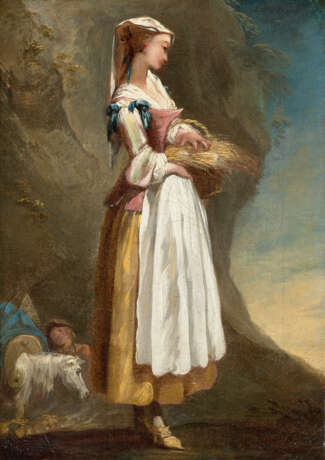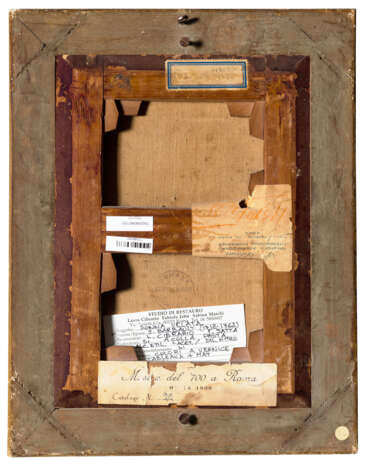ID 1437161
Lot 25 | JEAN BARBAULT (VIARMES 1718-1762 ROME)
Valeur estimée
€ 15 000 – 20 000
La Frascatane
huile sur toile
25 x 18 cm (9 7/8 x 7 in.)
Provenance
[Très probablement] Chez Galerie Matthiesen, Londres, en 1955 (selon D. Jacquot et al., 2010, voir infra).
L. Rocchetti, Rome, depuis au moins 1959 et jusqu'au moins 1975 (selon les catalogues d'exposition de 1959 et de 1974-1975, voir infra).
Collection particulière, Italie.
Literature
P. Rosenberg, 'Jean Barbault', Arte Illustrata, novembre 1972, 5e année, 51, p. 448 et p. 453, sous la note 22, reproduit en noir et blanc p. 430, fig. 38.
D. Jacquot et al., Jean Barbault (1718-1762). Le théâtre de la vie italienne, [cat. exp.], Strasbourg, 2010, p. 89, cat. 20, reproduit en noir et blanc.
Exhibited
Rome, Palazzo delle esposizioni, Il Settecento a Roma, 19 mars-31 mai 1959, n°22.
Beauvais, musée départemental de l’Oise ; Angers, musée des beaux-arts ; Valence, musée des beaux arts, Jean Barbault, 1718-1762, 3 octobre-15 novembre 1974 ; 1er décembre 1974-15 janvier 1975 ; 1er février-15 mars 1975, n°22.
Further details
JEAN BARBAULT (1718-1762), LA FRASCATANE, OIL ON CANVAS
Jean Barbault (1718-1762), a painter who was 'delicious and delectable, not without a touch of humour... an outstanding colourist', as Pierre Rosenberg describes him (Le siècle de Louis XV, peinture française de 1710 à 1774, Ottawa, 1976, pp. 28-29), remained in obscurity for a long time before being brought out of the shadows in 1974 with the first monographic exhibition devoted to his work.
Barbault's life was one of ups and downs: he began as a student of the austere Jean Restout (1692-1768) in Paris, but thanks to the esteem in which its director, Jean-François de Troy (1679-1752), held him, he was able to enter the Académie de Saint-Luc in Rome without passing the competitive examination. However, Barbault did not seem to benefit from the artistic abundance offered by the Eternal City. He ran up debts, married in secret and tried to swindle the Academy administration. Nevertheless, the painter was a great success with the foreign aristocrats and patricians who travelled to Italy at the time. Among his patrons were Prince and Princess Paul-Antoine Esterhazy (1711-1762), Joseph Roch Boyer de Fonscolombe (1721-1799) and Jean de Julienne (1686-1766), a great collector of paintings by Jean-Antoine Watteau (1684-1721).
In 1751, Barbault received a commission from Abel-François Poisson (1727-1781), Marquis de Vandières, better known by his later titles of Marquis de Marigny et de Ménars, younger brother of Madame de Pompadour (1721-1764) and Director of the King's Buildings, who asked him for twelve paintings depicting the costumes of Italy. A letter from Jean-François de Troy to the Marquis, dated 10 November 1751, states that Barbault had completed 'six of the twelve paintings you ordered ...These six paintings are: The Swiss of the Pope's Guard; The Pope's Coachman; The Hunter; The Frascatane; The Endowed Daughter; The Venetian ...' (see D. Jacquot, 2010, op. cit., p. 83.)
These paintings later passed into the collection of the Marquis's travelling companion, the architect Jacques-Germain Soufflot (1713-1780). In the catalogue of Soufflot's posthumous sale, it is noted that certain paintings not signed by Barbault were attributed to Pierre Subleyras (1699-1749). It is true that the rich subject matter and sumptuous colours, so beautifully displayed in La Frascatane, are close to the style of the Occitan painter, but the present composition, with its golden accents, could not be attributed to anyone other than Barbault.
The series of costumes from Italy became very popular, and Barbault took advantage of this, executing serveral versions of each composition. Each time, the artist changed small details by adding a landscape element, reversing the model's pose or changing the colours of the costume. For example, the horse and man in the bottom left-hand corner of our Frascatane are not included in the other known versions of the painting.
The pretty peasant woman in the composition comes from Frascati, a town in the Alban Hills near Rome. From the early sixteenth century onwards, leading Roman families began to build their country houses there. Embellished and enriched by successive generations, these houses became veritable castles. Thanks to the magnificence of St Peter's Cathedral, and renowned for its white wine, Frascati was also an obligatory stop on the route of the Grand Tour, which explains why Barbault chose to include a frascatane in his selection of typical costumes for patrons desirous of a souvenir of their Italian trip.
| Artiste: | Jean Barbault (1718 - 1762) |
|---|---|
| Technique appliquée: | Huile sur toile |
| Style artistique: | Vieux Maître |
| Genre: | Art de genre |
| Lieu d'origine: | Europe de l'Ouest, France, Europe |
| Catégorie maison de vente aux enchères: | Peintures, Aquarelles, Dessins, Peintures |
| Artiste: | Jean Barbault (1718 - 1762) |
|---|---|
| Technique appliquée: | Huile sur toile |
| Style artistique: | Vieux Maître |
| Genre: | Art de genre |
| Lieu d'origine: | Europe de l'Ouest, France, Europe |
| Catégorie maison de vente aux enchères: | Peintures, Aquarelles, Dessins, Peintures |
| Adresse de l'enchère |
CHRISTIE'S 8 King Street, St. James's SW1Y 6QT London Royaume-Uni | |
|---|---|---|
| Aperçu |
| |
| Téléphone | +44 (0)20 7839 9060 | |
| Commission | see on Website | |
| Conditions d'utilisation | Conditions d'utilisation |







